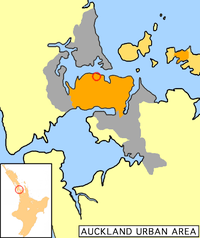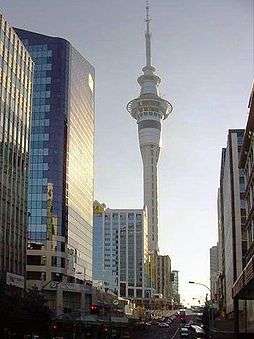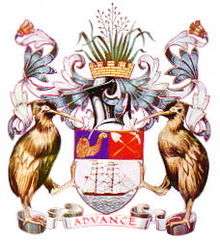Auckland City
| Auckland City | ||
|---|---|---|
| Former territorial authority of New Zealand | ||
| ||
|
Auckland City's location in the North Island | ||
 Auckland City's urban areas (in orange) within the greater Auckland urban region (grey). The city centre is ringed. Auckland City also encompassed islands of the inner (upper right) and outer Hauraki Gulf. | ||
| Country |
| |
| Region | Auckland | |
| Founded | 1871 | |
| Final extent formed | 1989 | |
| Disestablished | 1 November 2010 | |
| Seat | Auckland CBD | |
| Area | ||
| • Total | 637 km2 (246 sq mi) | |
| Time zone | NZST (UTC+12) | |
| • Summer (DST) | NZDT (UTC+13) | |
| Area code(s) | 09 | |
| Website | www.AucklandCity.govt.nz | |
Auckland City was a local authority district governed by Auckland City Council. It was the part of Auckland urban area covering the isthmus and most of the islands of the Hauraki Gulf. The core of Auckland City was the Auckland CBD, a major financial and commercial centre, surrounded by many suburbs.
It lay within the wider Auckland Region, which was governed by Auckland Regional Council. Auckland City was disestablished as a local government district on 1 November 2010, when Auckland City Council was amalgamated with other councils of the Auckland Region into the new Auckland Council.
Auckland City was the most populous district in the country, with a population of 450,000 at 30 June 2010.[1] In 2009, Auckland was rated the fourth-best place to live in the world, in human resources consultancy Mercer's annual survey.[2]
Geography
The mainland part of Auckland City occupied the Auckland isthmus, also known as the Tāmaki isthmus. The Waitemata Harbour, which opens to the Hauraki Gulf, separated North Shore City from the isthmus. The Manukau Harbour, which opens to the Tasman Sea, separated Manukau City from the isthmus. The distance between the two harbours is particularly narrow at each end of the isthmus. At the western end, the Whau River, an estuarial arm of the Waitemata Harbour, comes within two kilometres of the waters of the Manukau Harbour on the west coast and marks the beginning of the Northland Peninsula. A few kilometres to the southeast at Otahuhu, the Tamaki River, an arm of the Hauraki Gulf on the east coast, comes just 1200 metres from the Manukau's waters. Being part of the Auckland volcanic field, much of the isthmus is mantled with volcanic rocks and soils, and several prominent scoria cones dot the isthmus.
Many Hauraki Gulf islands were part of Auckland City. Such islands of the inner gulf included Rangitoto, Motutapu, Browns Island, Motuihe, Rakino, Ponui and Waiheke, while the outer gulf islands included Little Barrier, Great Barrier and the Mokohinau Islands.
Local government
In November 1989, central government restructured local authorities throughout New Zealand. After substantial protests and legal challenges, Auckland City was merged with eight smaller local authorities to form a new Auckland City Council. The new Auckland City had double the population of the old. However, amalgamation, forced onto local authorities often against their will, was criticised to have led to less democracy and higher rates for the same services.[3]
A further restructuring and amalgamation brought all seven councils in the area and the Auckland Regional Council into one "SuperCity" (Auckland Council), starting 1 November 2010.
Demography
Auckland City was the most populous city of New Zealand. In 2010 it was made up of 188 ethnic groups, making it New Zealand's most diverse city, and slightly more diverse than in 2007, when 185 ethnic groups had been counted.[4][5] In 2010, the life expectancy was 83 years for women, and 79.6 years for men, while the average age of the population was 33.4 years, with 35.9 years for the whole country.[4]
Economy

In the year to March 2009, Auckland City had 353,000 jobs, of which 26.3% was held by property and business services,[6] as well as 65,655 businesses, making up 13.1% of New Zealand's businesses and 16.2% of New Zealand's jobs.[7] Over 2009 to the month of March, Auckland City's unemployment rate increased to 5.6%, compared to the overall New Zealand unemployment rate of 4.5%. In addition the city's economic output declined by 2.4%.[6] Gareth Stiven, the economic manager of Auckland City, stated that this was because the city's economy was heavily involved with service industries, such as banking and insurance, which were affected by financial crises.[8] However, over the last five years of its existence, Auckland's economic growth averaged 1.4% each year, higher than the average of the region and the nation.[4]
In 2003 three of the ten largest companies in New Zealand (Air New Zealand, Fletcher Building, and Foodstuffs) were headquartered in Auckland City.[9] Many large corporations were housed within Auckland CBD, the central part of Auckland City.[9]
Air New Zealand has its worldwide headquarters, called "The Hub", off Beaumont and Fanshawe Streets in the Western Reclamation;[10][11] the airline moved there from the Auckland CBD in 2006.[10] In September 2003 Air New Zealand was the only one of the very largest corporations in New Zealand to have its headquarters within the Auckland CBD.[9]
Suburbs
These lists of suburbs are arranged electorally, by the wards, starting from the west.
- Avondale-Roskill
- Avondale, Blockhouse Bay, Lynfield, New Windsor, Hillsborough, Three Kings, Waikowhai, Mount Roskill, Sandringham, Wesley, Waterview
- Eden-Albert
- Balmoral, Morningside, Mount Albert, Mount Eden, Owairaka, Kingsland, Sandringham, Waterview
- Western Bays
- Grey Lynn, Newton, Western Springs, Point Chevalier, Westmere, Ponsonby, Herne Bay, Freemans Bay, Saint Marys Bay.
- Hobson
- Auckland CBD, Epsom, Greenlane, Newmarket, One Tree Hill, Parnell, Remuera, Mechanics Bay, Grafton, Newton.
- Eastern Bays
- Mission Bay, Kohimarama, Saint Heliers, Orakei, Glendowie, Meadowbank, Saint Johns
- Tamaki–Maungakiekie
- Glen Innes, Point England, Tamaki, Panmure, Mount Wellington, Ellerslie, Otahuhu, Westfield, Southdown, Penrose, Oranga, Te Papapa, Onehunga, Royal Oak, Stonefields
For the suburbs of the other cities within the Auckland urban area, see North Shore, Manukau, Waitakere and Papakura.
Roads
- Dominion Road – an arterial road running north–south across most of the central isthmus
- Great North Road – begins as a continuation of Karangahape Road and runs south-westward before crossing into what was Waitakere City
- Great South Road – runs south from Epsom and crosses from Otahuhu into what was Manukau City
- Karangahape Road – a commercial street running west–east and intersecting Queen Street at the southern edge of the CBD
- Portage Road – in Otahuhu, the southernmost suburb, following the path of a former Maori canoe portage between the Tamaki River and the Manukau Harbour, intersecting Great South Road
- Queen Street – the main commercial street, running south, uphill from Queens Wharf through the CBD
- Tamaki Drive – a coastal road running eastward from the eastern edge of the CBD to Saint Heliers
Sister cities and friendship cities
Auckland City had six sister cities and two friendship city relationships. All of these cities except Hamburg (Germany) are located around the Pacific Rim.[12]
Illustrations



See also
References
- ↑ "Subnational population estimates". table 2.
- ↑ Quality of Living global city rankings 2009: Mercer survey. Archived 2 May 2014 at the Wayback Machine. Mercer. 28 April 2009.
- ↑ Thompson, Wayne (6 September 2006). "Lessons from the history of local body amalgamation". The New Zealand Herald. Retrieved 17 September 2011.
- 1 2 3 "Report looks into the state of our city". CityScene. Auckland City Council. 29 August 2010.
- ↑ "Keeping Auckland's Future Bright: Auckland City Council Annual Report Summary 2006/2007" (PDF). Archived from the original (PDF) on 7 August 2011.
- 1 2 "Auckland business and economy report 2009". Archived 7 August 2011 at the Wayback Machine. City of Auckland. Retrieved on 15 September 2009.
- ↑ Eriksen, Alanah May. "Optimistic outlook for city economy." The New Zealand Herald. Tuesday 19 August 2008. Retrieved on 7 September 2009.
- ↑ "Auckland's economy drags but recovery on way." TVNZ. Friday 14 August 2009. Retrieved on 7 September 2009.
- 1 2 3 "The Economy of Auckland’s Central Business District". Archived 22 February 2012 at the Wayback Machine. City of Auckland. September 2003. 10 (20/77). Retrieved on 7 September 2009.
- 1 2 Gibson, Anne. "Air NZ readies for headquarters shift." The New Zealand Herald. 14 August 2006. Retrieved on 26 August 2009.
- ↑ Taylor, Colin. "Big piece of Viaduct for little guys." New Zealand Herald. Saturday 21 October 2006. Retrieved on 5 March 2010.
- ↑ International partnerships Archived 18 August 2006 at the Wayback Machine. (from the Auckland City Council website. Retrieved 7 October 2006.)
- ↑ "Guangzhou Sister Cities". Guangzhou Foreign Affairs Office. Archived from the original on 24 October 2012. Retrieved 21 July 2013.
- ↑ Orsman, Bernard (2 March 2007). "Oops! Sister cities cost an extra $150,000". The New Zealand Herald. Retrieved 24 May 2007.
- A Complete Guide To Heraldry by A.C. Fox-Davies 1909.
External links
| Wikivoyage has a travel guide for Central Auckland. |
- Auckland City Council website, the local authority for Auckland
- History of Auckland City by Graham Bush
- Heart of the City website by the Auckland CBD business' association
- Heritage Walks: The Engineering Heritage of Auckland, historic text, 360° panoramas and heritage imagery accessed through an interactive map
Coordinates: 36°52′23″S 174°45′18″E / 36.873°S 174.755°E
